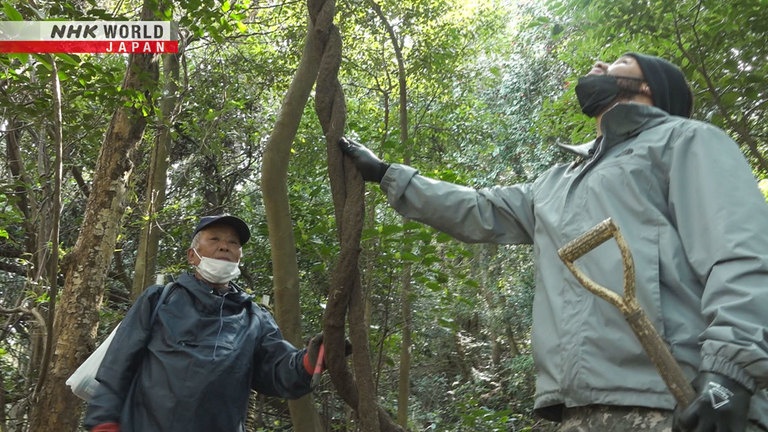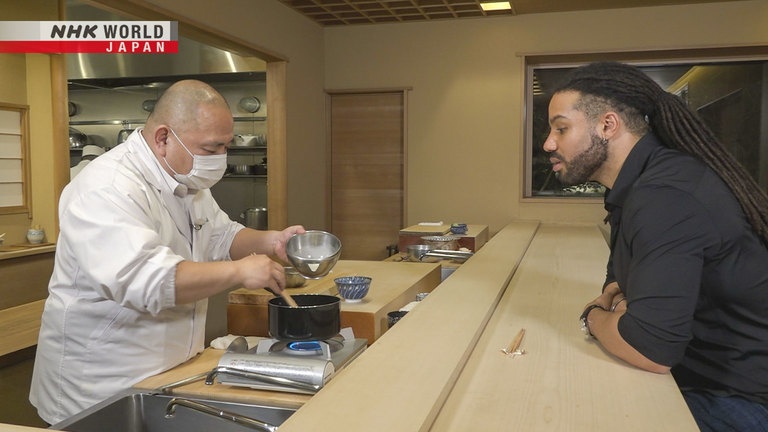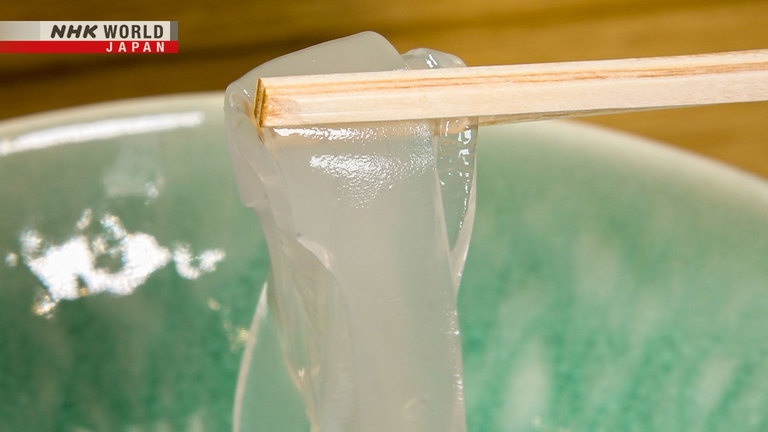KUZU
Kuzu plays a key role in Japanese cuisine, from savory to sweet. The starch can be mixed in hot water to form a clear jelly, or used to thicken sauces and soups. The raw material is found deep in the mountains. Our journey takes us from harvest to factory, detailing a long process that remains largely unchanged for over 200 years. Feast your eyes on exquisite food featuring kuzu, an unsung hero of Japan's culinary culture. (Reporter: Alexander W. Hunter)




Transcript
Tokyo: this world-class metropolis is a veritable gourmet wonderland.
Discover the stories behind the ingredients that make this city so delicious - so "oishii."
Can you guess what this white stuff is?
Hint: it's an important part of Japan's food culture.
The answer is kuzu.
Since long ago, it's played a key supporting role in Japanese cuisine, from savory to sweet.
When mixed and boiled in water, you get this!
A shiny food that's been loved for generations.
Far off the beaten path, head to the mountains for a kuzu harvest... surrounded by nature.
This is a hike. Into the wild.
Kuzu is deeply rooted in Japan's food culture.
Dig in to find out more!
Trails to Oishii Tokyo.
Hello, everybody. My name is Hunter, and the theme for this episode is Kuzu.
It's a food.
I've never heard of it before.
So, let's see what it's all about.
Hunter begins at a kuzu-focused cafe in central Tokyo.
- Hello.
- Welcome.
I heard you have kuzu here.
That's right.
There's a white product by the door.
- May I?
- Sure.
So this is kuzu. Wow.
Kuzu powder.
Owner Sato Shigekazu begins with a popular dish.
This is kuzu-kiri.
Nice. How should I eat this?
It comes with kuromitsu syrup and matcha syrup.
- Matcha syrup?
- They are the dips.
It's like eating noodles.
- This is a first for me.
- First time?
Yes.
Here we go.
"Oishii."
- Interesting texture.
- Right, kuzu-kiri is pretty unique.
Chewy but easy to eat.
Exactly.
Fun to chew, and easy to gulp down.
Kuzu-kiri is often served with a sweet syrup called kuromitsu.
On its own, kuzu has a slightly bitter flavor.
Let's see how it's made.
Dissolve kuzu powder in water.
- It starts off white like this.
- It dissolves quickly?
Right. The blocks break apart
and dissolve easily in water.
The liquid is put into a square copper pan that's partially submerged in hot water.
Kuzu is a starch that thickens when heated.
Once a sheet forms, the pan is fully submerged.
This turns the kuzu from white to clear!
Now place it in cold water.
It becomes a clear jelly.
How cool!
Slice it up...
and it's ready to eat.
Sato says kuzu is only good for about 10 minutes after it's made.
It hardens quickly, so it needs to be enjoyed while the texture is just right.
Up next...
- This is kuzu-mochi.
- Wonderful.
How is this made?
For this, the white mixture
is stirred in a pan over heat.
Cool. Very clear.
It's similar to mochi, actually.
Right. More elastic than the previous dish.
Kuzu-mochi is plump and gelatinous.
And this is kuzu-neri, softer than kuzu-mochi.
It's served as-is, nice and moist.
It looks like a jellyfish.
Right. Very plump.
It's warm.
Freshly-made.
This is great.
All three dishes were made with
just kuzu powder and water.
But they have different textures.
That's amazing. The cooking method
makes all the difference.
Kuzu has been a part of Japanese cuisine for centuries.
In fact, a cookbook from the Edo period shows 10 different ways to eat it.
To this day, kuzu remains an important facet of the country's food culture.
Next, Hunter visits a restaurant in Kagurazaka, Tokyo.
He'll try kuzu dishes by owner chef, Komuro Mitsuhiro.
This traditional favorite contains kuzu - sesame tofu.
Actually, sesame and kuzu are the only ingredients.
Very good.
It's plump at first,
then breaks apart nicely.
It's a fun experience of textures.
Right. Kuzu brings unique textures.
Here's how it's made.
Kuzu and sesame paste are mixed in water, which is then strained using a cloth.
This is done carefully by hand.
The mixture is stirred with a spatula over heat for about 30 minutes.
The thick paste is poured into a mold, chilled, and then served.
It's really plump.
Just like my belly.
Stirring it well does that.
Kuzu is pretty unique in that sense.
Next, he'll demonstrate an everyday use for kuzu.
- Is that kuzu?
- Kuzu dissolved in dashi stock.
Soup stock thickened with kuzu is called kuzu-an.
Kuzu is Japan's answer to corn and potato starch.
It's an old-school thickener.
No idea how this will taste...
Thank you! It looks wonderful.
It's quite thick and gooey.
Right, so it retains heat.
- Be careful.
- I have a sensitive tongue.
The dashi and shrimp flavors stand out.
It would be much blander without kuzu.
Kuzu-an clings to the shrimp and other flavors,
and spreads them out.
Without kuzu, the broth would just
wash over the ingredients.
Komuro has one more trick up his sleeve.
Coat the sea bream.
- Is that...?
- Kuzu, yeah.
Kuzu gives boiled fish a shiny, clear coating.
Smells wonderful.
Very flavorful.
The powder keeps the fish umami
from escaping into the soup.
- It locks it in.
- Right.
Interesting.
There are many recipes that
aren't possible without kuzu.
I use it in every course.
There's always a place for it.
I'm learning a lot.
Osumi Peninsula in southern Japan is a major kuzu production area.
The raw material is found here, deep in the mountains.
- Hello
- Hi.
I'm Hunter.
Ikeda Shigeo has been harvesting kuzu for 50 years.
He lets Hunter tag along.
Ikeda has a ritual for entering the forest.
He makes offerings to the sacred, gracious mountains, and prays for a safe day of work.
Big area.
Watch your step.
- Into the mountains we go.
- Right!
This is a hike.
Into the wild.
Where's the kuzu?
Look here!
This is what we've been looking for.
- A kuzu tree!
- This?
- It's over 100 years old.
- Really?
See the vines?
That's where starch is made.
They grow upward and spread out,
and produce starch in the sunlight.
The roots store starch during the winter,
and the process repeats.
Kuzu vines are a member of the pea family.
At 2 to 3 years old, vines are only about 2 centimeters thick.
Ikeda hunts for trees with darker, thicker vines aged 30 years or more.
Is that a kuzu tree?
Bullseye!
You got it.
Nice.
I'm getting the hang of it.
He begins digging around the roots.
Follow the roots.
Tap down with the shovel.
Dig where you hear a nice sound.
Here.
I see.
They find roots after about 15 minutes.
Hunter's in charge of cutting off a section.
- This is our harvest.
- Great!
Kuzu powder is made from this.
The root!
Vines grow vigorously in the summer, covering the mountains with green leaves.
The starch they produce - the soul of kuzu powder - is stored in the roots during the winter.
Kuzu trees only grow deep in the mountains, far from roads, so roots are dug up by hand even today.
This is kuzu.
This is the roots of these trees that becomes the kuzu powder that we've already seen.
But, wow, I had no idea that this is what it looks like in its natural state.
Today's haul: 17 kilograms.
Ikeda often hauls up to 40 kilograms by himself.
The roots are taken to a processing plant.
Around 20 kuzu pickers share the facility.
Hello. I'm Hunter.
Hunter! That's a mighty name.
Thanks. Nice to meet you.
I'm Takaki Kyusuke,
a 10th-generation kuzu producer.
Welcome.
Ten generations.
How long is that?
We've been doing this for over 200 years.
A document from 1828 shows how kuzu was produced back then.
With some modernization, the basics remain the same, as passed down over two centuries.
First, the roots are run through a compressor to create small fibrous pieces.
These are mixed with water and sent through pipes into a large sieve.
The starch dissolves and passes through a mesh filter.
That mixture gets stored in here.
Kuzu powder is now being precipitated from the liquid.
The white part is kuzu.
Very white.
This base material is called so-kuzu.
Once moisture is removed, it's sent to a powder processing factory.
Hunter's next stop is Akizuki, a castle town in the mountains of Fukuoka.
Thanks to the abundance of cold, natural spring water,
the area has been a key producer of kuzu powder since long ago.
- In here?
- Yes. That's kuzu.
Starch purification is the most important step.
First, so-kuzu and spring water are placed in a large vat.
The starch components precipitate over three days.
The leftover water, containing impurities, is then discarded.
We repeat the process 10 times,
removing impurities.
The purer it gets, the whiter it becomes.
I see.
After about a month, large clumps begin to form.
These are taken out and flattened by hand.
Doing this releases trapped air, which would cause fermentation.
Air bubbles burst with every hit.
The kuzu air-dries for six to 12 months.
As moisture is released slowly over time, a fine, soluble powder is formed.
This is where we dry it.
So this is how it's done.
It makes a certain sound
when it's good and dry.
It's ready?
You can tell by the squeaky sound.
The long process is complete.
However, 100 grams of root only makes 7 grams of precious white powder.
We only use the best batches,
so it's often called white gold.
That sounds expensive.
The whole process, from harvest
to production, takes up to 1.5 years.
And only a portion of that is used,
so it's as precious as gold.
It's amazing that this all started
with digging up roots.
Takaki will show Hunter a recipe that can be made at home.
This is kuzu-yu.
You can make it at home.
Just add boiling water to powder.
Stir to thicken it, then add ginger.
Ginger?
Nice and thick.
Yummy.
It's something a parent or grandparent would make.
Like when you have a cold or stomach ache.
This would make it all better.
Nice.
Kuzu has a long shelf life, so, really, you can make this anytime you want.
It's easy!
In the past, kuzu was often used for medicinal purposes.
It's amazing what only water and kuzu can do.
Back in Tokyo, Hunter heads to Minami-aoyama.
This restaurant fuses Japanese and French cuisine.
Chef Narukami Masakazu is a big fan of kuzu.
What does kuzu mean to you?
I make French cuisine,
so sauces are very important.
Kuzu is easy to work with,
so I use it for sauces a lot.
You make sauce with kuzu?
Right. I'll make two kinds today.
For the first sauce, port and red wines are simmered down to a paste.
Sake, mirin, and soy sauce are added for a Japanese touch.
Then, he adds beef bone fond de veau.
Kuzu dissolved in water brings it all together.
Normally, you'd use gelatin or fats like oil and butter.
But kuzu is a healthier way to tie flavors together.
For this, kuzu is used instead of butter.
Getting thicker.
Nice.
Chicken liver and vegetables placed in wine and kuzu sauce.
Itadakimasu.
I can taste the liver.
And the sauce adds a slight sweetness.
Right.
People say French food is too rich.
That's because the French dishes that were
once popular in Japan used a lot of butter.
Getting rich flavor without heavy ingredients,
that's the beauty of using kuzu.
Now for the next sauce.
He adds kuzu to fish and vegetable stocks to make a savory kuzu-an that's placed over flan.
Everything is so soft.
"Oishii."
There are many ways to thicken a sauce.
Why use kuzu?
You can use corn or potato starch,
but that makes things heavy.
Kuzu is lighter and easier on the palate.
It has a nice sheen, but doesn't look so heavy.
That's the great thing about kuzu.
It's a special ingredient.
At the beginning of this episode, I knew absolutely nothing about kuzu.
Because if you see the kuzu powder, you don't immediately know what it takes to make that.
We've eaten the food, of course. We went to the mountains and we dug up kuzu.
We went to the factory that processes the kuzu powder and,
you know, now that I understand the step-by-step process, it's really more than just a food item.
It's a lot deeper than that.
And I learned a lot.
And I hope you did, too.
In Tokyo, every ingredient has its own story.